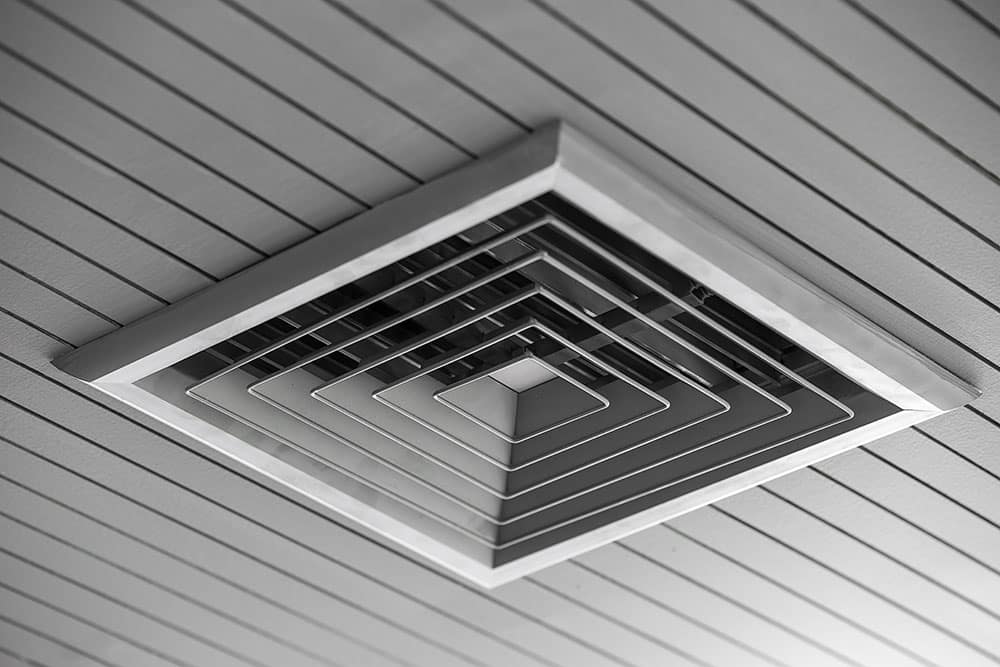A mini split ceiling cassette recesses into your ceiling, and it blows out warm or cool air. Named after their resemblance to audio cassettes, ceiling-mounted cassettes connect to an outdoor condenser, and they use heat pump technology to heat and air condition your home. Keep reading to learn more about how they work.

How Heat Pumps Work
Unlike most traditional heating sources, heat pumps don’t generate heat. Instead, they extract heat from the outside air. The refrigerant in the outdoor condenser absorbs the extracted heat. Then, the warm refrigerant travels through very small tubes which lead to the ceiling-mounted cassette. At this point, a fan blows air over the warm refrigerant, releasing warmth into your room.
During the summer, this process works in reverse. The ceiling cassette extracts heat from your home. Then, the warm refrigerant goes to the outdoor condenser where it cools down, and the process starts again. You can buy heat pumps that only provide AC, but most homeowners prefer having both.
Why Ceiling Cassettes Are So Efficient
Heat pumps are more efficient than most other heating options because they move heat rather than make heat. As a result, they put out more energy than they consume in electricity. Their ductless design also means that you don’t have to worry about hot or cold air seeping out of your ductwork. This reduces most homeowners’ heating and cooling bills.
Ceiling-mounted units can often provide even more efficiency than wall-mounted units. In particular, if you opt for a cassette that offers multi-direction airflow, that increases the comfort in your home. Thanks to this technology, most people find that they can keep their thermostat at a lower setting than they normally would.
How Zones Work
Each ductless ceiling cassette connects directly to the outdoor condenser, and it facilitates the heating and cooling process for a single zone of your home. Each zone has its own thermostat. That helps you save money because you can customize the settings based on how you use the space.
You may only need one zone if you have a small home on a single level or if you only want to heat and cool a single room such as a basement, attic, or room above the garage. Most homes, however, need two or more zones. A multi-zone outdoor condenser can connect to up to eight indoor air handling units. It’s very rare for a home to need more zones than that.
Your comfort consultant will help you select the optimal number of zones in your home. Keep in mind that you don’t have to have the same indoor air handling units for each zone. In some cases, you may want ceiling cassettes in some areas and wall mounts in others.
Ducted Vs. Ductless Ceiling Cassettes
Depending on the layout of your home, you may end up combining ducted and ductless technology. This often happens with bedrooms located on the second floor. Some people put a separate indoor air handling in every bedroom, turning each bedroom into its own zone.
Alternatively, however, you can put an air-handling unit in the attic. Then, you can run short ducts to each of the bedrooms. The ducts deliver warm or cool air through registers in the ceilings of the room. This means that you don’t have a separate thermostat for each room, but it can reduce the overall cost of the equipment.
Additional Features of Ceiling-Mounted Ductless Units
In addition to heating and cooling your home, ductless units also filter the air in your home. The air runs through an advanced filtration system that helps to remove dust and allergens. You can also use the unit to dehumidify your home. This is especially helpful for basements or homes in wet climates.
Installing a Ductless Ceiling Cassette
Some ductless units can mount to your ceiling. Like a wall-mounted unit, they attach to the joists in your ceiling, and they sit on the outside of the sheetrock. Generally, however, people only gravitate to this option if their ceiling cavity doesn’t have enough space for a recessed unit.
In contrast, when installing a recessed ceiling unit, the installer makes a hole in the ceiling. Then, the unit sips into the cavity above the ceiling. Depending on the shape of the unit, it may fit right between the joists, or a carpenter may need to make adjustments.
Once the unit is installed in the ceiling, the installer runs refrigerant, electrical, and drainage lines from that unit to the outdoor condenser. Typically, the lines go through the ceiling to an outer wall and then down the outside of the home to the condenser.
Contact Us About Ceiling-Mounted Ductless Units Today
Love the sound of a ductless ceiling cassette? Want to improve efficiency and comfort in your home? Then, contact us today. At NETR, Inc, we have over 30+ years of experience making clients comfortable, and we could love to help you find the right solution for your home or business.

